TPMS HONDA ACCORD HYBRID 2017 9.G Quick Guide
[x] Cancel search | Manufacturer: HONDA, Model Year: 2017, Model line: ACCORD HYBRID, Model: HONDA ACCORD HYBRID 2017 9.GPages: 80, PDF Size: 10.35 MB
Page 4 of 80
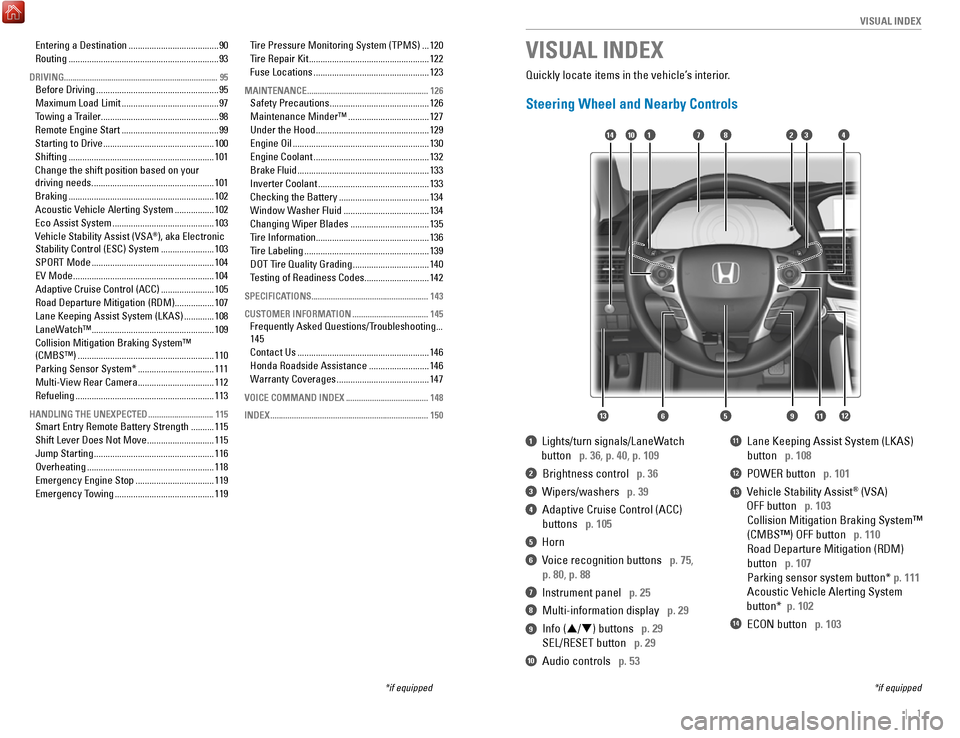
| 1
V
ISUAL INDEX
1 Lights/turn signals/LaneWatch
button p. 36, p. 40, p. 109
2 Brightness control p. 36
3 Wipers/washers p. 39
4 Adaptive Cruise Control (ACC)
buttons p. 105
5 Horn
6 voice recognition buttons p. 75,
p. 80,
p. 88
7 Instrument panel p. 25
8 Multi-information display p. 29
9 Info (p/ q) buttons p. 29
SeL/reSeT button p. 29
10 Audio controls p. 53
11 Lane Keeping Assist System (LKAS)
button p. 108
12 PoWer button p. 101
13 vehicle Stability Assist® (vSA)
oFF button p. 103
Collision Mitigation Braking System™
(CMBS™) oFF button p. 110
road Departure Mitigation (rDM)
button p. 107
Parking sensor system button* p. 111
Acoustic vehicle Alerting System
button* p. 102
14 eCoN button p. 103
VISUAL INDEX
*if equipped *if equipped
Quickly locate items in the vehicle’s interior.
Steering Wheel and Nearby Controls
12
5
107414
6
38
9111213
entering a Destination .......................................90
routing ................................................................. 93
DRIVING....................................................................... 95Before Driving .....................................................95
Maximum Load Limit
.......................................... 97
Towing a T
railer...................................................98
remote engine Start .......................................... 99
Starting to Drive
................................................ 100
Shifting
............................................................... 101
Change the shift position based on your
driving needs.
.................................................... 101
Braking
............................................................... 102
Acoustic
vehicle Alerting System ................. 102
eco Assist System ............................................ 103
vehicle Stability Assist (vSA®), aka electronic
Stability Control (eSC) System ....................... 103
SP
orT Mode ..................................................... 104
ev Mode ............................................................. 104
Adaptive Cruise Control (ACC)
....................... 105
road Departure Mitigation (rDM) .................107
Lane Keeping Assist System (LKAS)
............. 108
LaneWatch™
..................................................... 109
Collision Mitigation Braking System™
(CMBS™)
........................................................... 110
Parking Sensor System*
................................. 111
Multi-
view rear Camera ................................. 112
refueling ............................................................ 113
HANDLING THE UNEXPECTED ..............................115Smart entry remote Battery Strength ..........115
Shift Lever Does Not Move
............................. 115
Jump Starting
.................................................... 116
overheating ....................................................... 118
emergency engine Stop ..................................119
emergency Towing ........................................... 119Tire Pressure Monitoring System (TPMS)
...
120
Tire
repair Kit .................................................... 122
Fuse Locations
.................................................. 123
MAINTENANCE ........................................................ 126Safety Precautions ...........................................126
Maintenance Minder™
................................... 127
Under the Hood
................................................. 129
engine oil ........................................................... 130
engine Coolant ..................................................132
Brake Fluid
......................................................... 133
Inverter Coolant
................................................ 133
Checking the Battery
....................................... 134
Window Washer Fluid
..................................... 134
Changing Wiper Blades
.................................. 135
Tire Information
.................................................136
Tire Labeling
...................................................... 139
D
oT Tire Quality Grading ................................. 140
Testing of
readiness Codes ............................ 142
SPECIFICATIONS...................................................... 143
CUSTOMER INFORMATION
................................... 145Frequently Asked Questions/Troubleshooting ...
145
Contact Us
......................................................... 146
Honda
roadside Assistance .......................... 146
Warranty Coverages
........................................ 147
VOICE COMMAND INDEX ......................................148
INDEX
........................................................................\
. 150
Page 17 of 80
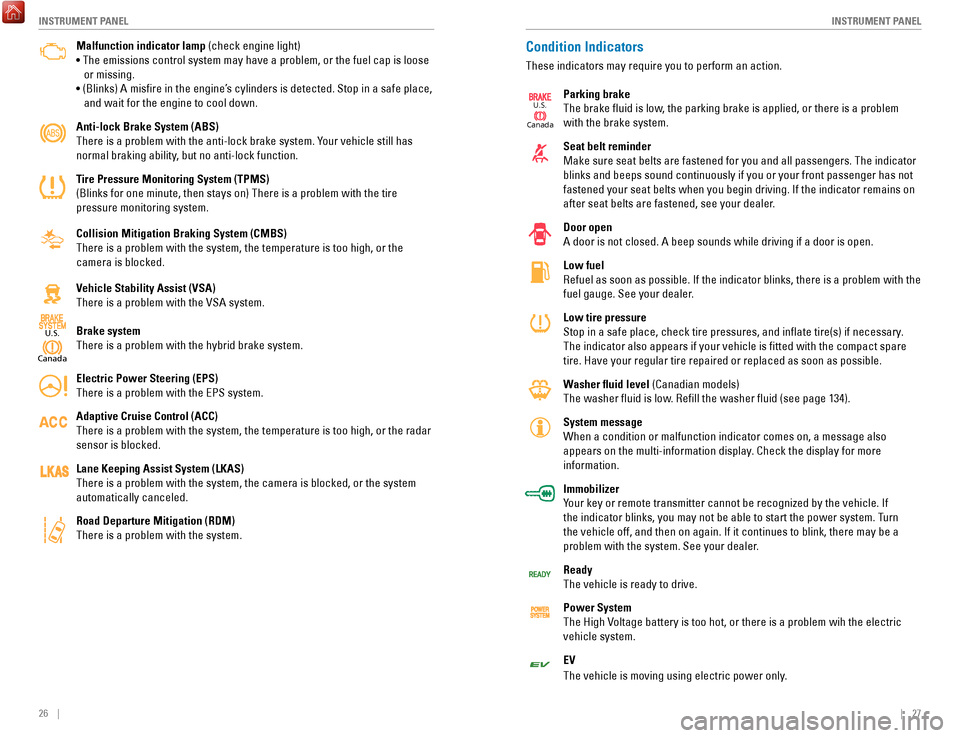
26 || 27
I
NSTRUMENT PANELINSTRUMENT PANEL
Malfunction indicator lamp (check engine light)
• The emissions control system may have a problem, or the fuel cap is\
loose
or missing.
• (Blinks) A
misfire in the engine’s cylinders is detected. Stop in a safe place,
and wait for the engine to cool down.
Anti-lock Brake System (ABS)
There is a problem with the anti-lock brake system. Y
our vehicle still has
normal braking ability, but no anti-lock function.
Tire Pressure Monitoring System (TPMS)
(Blinks for one minute, then stays on) There is a problem with the tir\
e
pressure monitoring system.
Collision Mitigation Braking System (CMBS)
There is a problem with the system, the temperature is too high, or the \
camera is blocked.
Vehicle Stability Assist (VSA)
There is a problem with the
vSA system.
Brake system
There is a problem with the hybrid brake system.
Electric Power Steering (EPS)
There is a problem with the
ePS system.
Adaptive Cruise Control (ACC)
There is a problem with the system, the temperature is too high, or the \
radar sensor is blocked.
Lane Keeping Assist System (LKAS)
There is a problem with the system, the camera is blocked, or the system\
automatically canceled.
Road Departure Mitigation (RDM)
There is a problem with the system.
Canad a
U.S.
Condition Indicators
These indicators may require you to perform an action.
Parking brake
The brake fluid is low, the parking brake is applied, or there is a problem
with the brake system.
Seat belt reminder
Make sure seat belts are fastened for you and all passengers. The indicator
blinks and beeps sound continuously if you or your front passenger has not
fastened your seat belts when you begin driving. If the indicator remain\
s on
after seat belts are fastened, see your dealer.
Door open
A door is not closed. A beep sounds while driving if a door is open.
Low fuel
refuel as soon as possible. If the indicator blinks, there is a problem w\
ith the
fuel gauge. See your dealer
.
Low tire pressure
Stop in a safe place, check tire pressures, and inflate tire(s) if n\
ecessary.
The indicator also appears if your vehicle is fitted with the compact \
spare
tire. Have your regular tire repaired or replaced as soon as possible.
Washer fluid level (Canadian models)
The washer fluid is low.
refill the washer fluid (see page 134).
System message
When a condition or malfunction indicator comes on, a message also
appears on the multi-information display. Check the display for more
information.
Immobilizer
Y
our key or remote transmitter cannot be recognized by the vehicle. If
the indicator blinks, you may not be able to start the power system. Turn
the vehicle off, and then on again. If it continues to blink, there may \
be a
problem with the system. See your dealer.
Ready
The vehicle is ready to drive.
Power System
The High
voltage battery is too hot, or there is a problem wih the electric
vehicle system.
EV
The vehicle is moving using electric power only.
Canad a
U.S.
Page 64 of 80
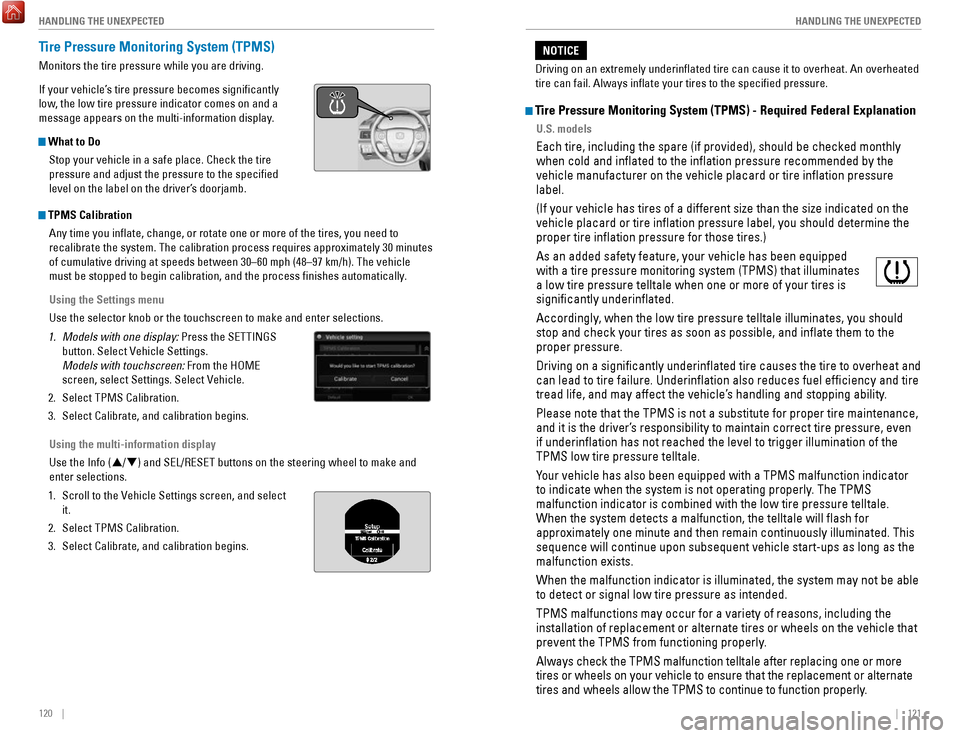
120 || 121
HANDLING THE UNEXPECTED
HANDLING THE UNEXPECTED
Tire Pressure Monitoring System (TPMS)
Monitors the tire pressure while you are driving.
If your vehicle’s tire pressure becomes significantly
low, the low tire pressure indicator comes on and a
message appears on the multi-information display.
What to Do
Stop your vehicle in a safe place. Check the tire
pressure and adjust the pressure to the specified
level on the label on the driver’s doorjamb.
TPMS CalibrationAny time you inflate, change, or rotate one or more of the tires, you \
need to
recalibrate the system. The calibration process requires approximately 3\
0 minutes
of cumulative driving at speeds between 30–60 mph (48–97 km/h). \
The vehicle
must be stopped to begin calibration, and the process finishes automat\
ically.
Using the Settings menu
Use the selector knob or the touchscreen to make and enter selections.
1.
Models with one display: Press the SeTTINGS
button. Select
vehicle Settings.
Models with touchscreen: From the H
oMe
screen, select Settings. Select
vehicle.
2.
Select TPMS Calibration.
3.
Select Calibrate, and calibration begins.
Using the multi-information display
Use the Info (p/
q) and S
eL/reSeT buttons on the steering wheel to make and
enter selections.
1.
Scroll to the vehicle Settings screen, and select
it.
2.
Select TPMS Calibration.
3.
Select Calibrate, and calibration begins.
Tire Pressure Monitoring System (TPMS) - Required Federal Explanation
U.S. models
each tire, including the spare (if provided), should be checked monthly\
when cold and inflated to the inflation pressure recommended by the \
vehicle manufacturer on the vehicle placard or tire inflation pressure\
label.
(If your vehicle has tires of a different size than the size indicated \
on the
vehicle placard or tire inflation pressure label, you should determine\
the
proper tire inflation pressure for those tires.)
As an added safety feature, your vehicle has been equipped
with a tire pressure monitoring system (TPMS) that illuminates
a low tire pressure telltale when one or more of your tires is
significantly underinflated.
Accordingly, when the low tire pressure telltale illuminates, you should
stop and check your tires as soon as possible, and inflate them to the\
proper pressure.
Driving on a significantly underinflated tire causes the tire to ove\
rheat and
can lead to tire failure. Underinflation also reduces fuel efficienc\
y and tire
tread life, and may affect the vehicle’s handling and stopping ability
.
Please note that the TPMS is not a substitute for proper tire maintenanc\
e,
and it is the driver’s responsibility to maintain correct tire pressure, even
if underinflation has not reached the level to trigger illumination of\
the
TPMS low tire pressure telltale.
Your vehicle has also been equipped with a TPMS malfunction indicator
to indicate when the system is not operating properly. The TPMS
malfunction indicator is combined with the low tire pressure telltale.
When the system detects a malfunction, the telltale will flash for
approximately one minute and then remain continuously illuminated. This \
sequence will continue upon subsequent vehicle start-ups as long as the \
malfunction exists.
When the malfunction indicator is illuminated, the system may not be abl\
e
to detect or signal low tire pressure as intended.
TPMS malfunctions may occur for a variety of reasons, including the
installation of replacement or alternate tires or wheels on the vehicle \
that
prevent the TPMS from functioning properly.
Always check the TPMS malfunction telltale after replacing one or more
tires or wheels on your vehicle to ensure that the replacement or altern\
ate
tires and wheels allow the TPMS to continue to function properly.
Driving on an extremely underinflated tire can cause it to overheat. A\
n overheated
tire can fail. Always inflate your tires to the specified pressure.
NOTICE
Page 72 of 80
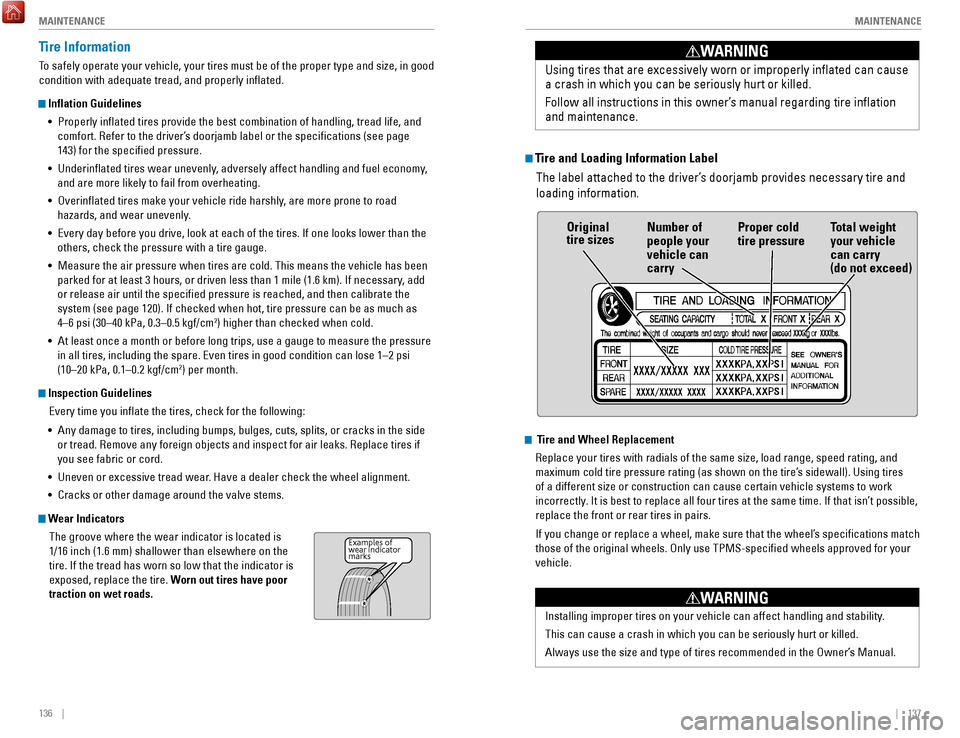
136 || 137
M
AINTENANCEMAINTENANCE
Tire Information
To safely operate your vehicle, your tires must be of the proper type and\
size, in good
condition with adequate tread, and properly inflated.
Inflation Guidelines
•
Properly inflated tires provide the best combination of handling, trea\
d life, and
comfort.
refer to the driver’s doorjamb label or the specifications (see page
143) for the specified pressure.
•
Underinflated tires wear unevenly, adversely affect handling and fuel economy,
and are more likely to fail from overheating.
•
overinflated tires make your vehicle ride harshly, are more prone to road
hazards, and wear unevenly
.
•
every day before you drive, look at each of the tires. If one looks lower\
than the
others, check the pressure with a tire gauge.
•
Measure the air pressure when tires are cold. This means the vehicle has been
parked for at least 3 hours, or driven less than 1 mile (1.6 km). If n\
ecessary
, add
or release air until the specified pressure is reached, and then calib\
rate the
system (see page 120). If checked when hot, tire pressure can be as mu\
ch as
4–6 psi (30–40 kPa, 0.3–0.5 kgf/cm
2) higher than checked when cold.
•
At least once a month or before long trips, use a gauge to measure the p\
ressure
in all tires, including the spare.
even tires in good condition can lose 1–2 psi
(10–20 kPa, 0.1–0.2 kgf/cm2) per month.
Inspection Guidelines
every time you inflate the tires, check for the following:
•
Any damage to tires, including bumps, bulges, cuts, splits, or cracks in\
the side
or tread.
remove any foreign objects and inspect for air leaks. replace tires if
you see fabric or cord.
•
Uneven or excessive tread wear. Have a dealer check the wheel alignment.
•
Cracks or other damage around the valve stems.
Wear Indicators The groove where the wear indicator is located is
1/16 inch (1.6 mm) shallower than elsewhere on the
tire. If the tread has worn so low that the indicator is
exposed, replace the tire. Worn out tires have poor
traction on wet roads.
Examples of
wear indicator
marks
Tire and Loading Information Label
The label attached to the driver’s doorjamb provides necessary tire and
loading information. Using tires that are excessively worn or improperly inflated can cause\
a crash in which you can be seriously hurt or killed.
Follow all instructions in this owner’s manual regarding tire inflation
and maintenance
.
WARNING
Tire and Wheel Replacement
replace your tires with radials of the same size, load range, speed ratin\
g, and
maximum cold tire pressure rating (as shown on the tire’
s sidewall). Using tires
of a different size or construction can cause certain vehicle systems to\
work
incorrectly. It is best to replace all four tires at the same time. If that isn’\
t possible,
replace the front or rear tires in pairs.
If you change or replace a wheel, make sure that the wheel’s specifications match
those of the original wheels.
only use TPMS-specified wheels approved for your
vehicle.
Original
tire sizes Number of
people your
vehicle can
carry Proper cold
tire pressure
Total weight
your vehicle
can carry
(do not exceed)
Installing improper tires on your vehicle can affect handling and stabil\
ity.
This can cause a crash in which you can be seriously hurt or killed.
Always use the size and type of tires recommended in the
owner’s Manual.
WARNING
Page 80 of 80
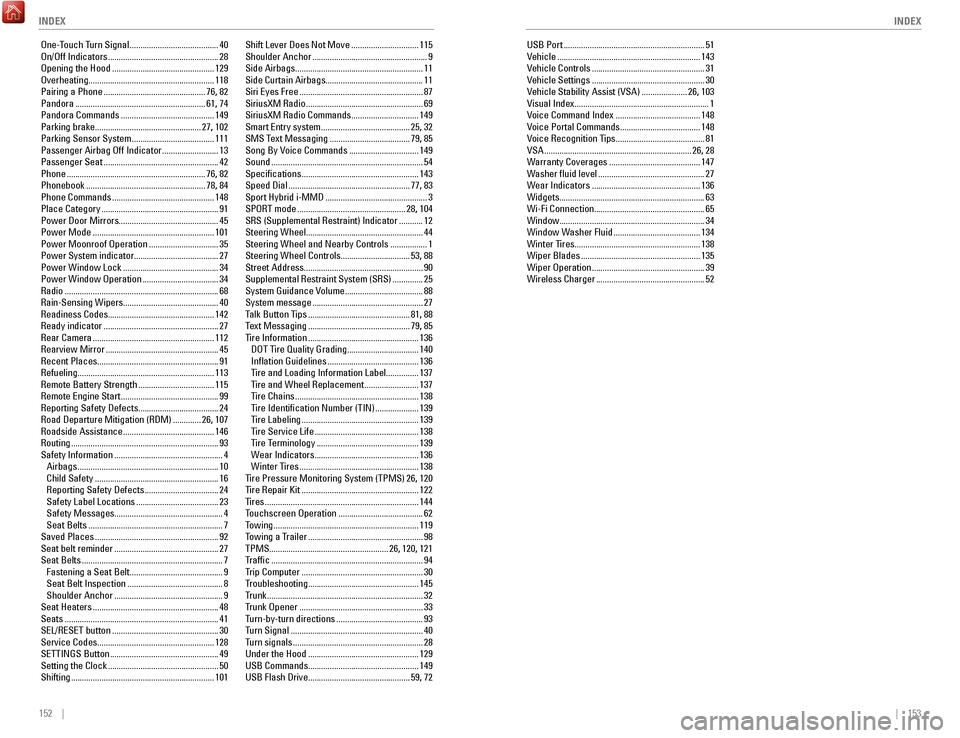
152 || 153
INDEX
INDEX
one-Touch Turn Signal ......................................... 40on/off Indicators ................................................... 28opening the Hood ...............................................129overheating..........................................................
118
Pairing a Phone
............................................... 76,
82
Pandora
............................................................ 61,
74
Pandora Commands
........................................... 149
Parking brake.................................................
27, 102
Parking Sensor System
...................................... 111
Passenger Airbag off Indicator .......................... 13
Passenger Seat ..................................................... 42
Phone ................................................................ 76,
82
Phonebook
....................................................... 78,
84
Phone Commands
............................................... 148
Place Category ...................................................... 91
Power Door Mirrors..............................................
45
Power Mode
........................................................ 101
Power Moonroof operation ................................ 35
Power System indicator.......................................
27
Power Window Lock
............................................ 34
Power Window operation ................................... 34radio ....................................................................... 68rain-Sensing Wipers............................................
40
readiness Codes.................................................
142
ready indicator .....................................................27rear Camera ........................................................ 112rearview Mirror ....................................................45recent Places........................................................
91
refueling...............................................................
113
remote Battery Strength ...................................115remote engine Start ............................................. 99reporting Safety Defects.....................................
24
road Departure Mitigation (rDM) .............26,
107
roadside Assistance ..........................................146routing .................................................................... 93
Safety Information .................................................. 4
Airbags ................................................................. 10
Child Safety ......................................................... 16reporting Safety Defects ..................................24
Safety Label Locations ...................................... 23
Safety Messages .................................................. 4
Seat Belts .............................................................. 7
Saved Places ......................................................... 92
Seat belt reminder ................................................ 27
Seat Belts ................................................................. 7
Fastening a Seat Belt ........................................... 9
Seat Belt Inspection ............................................ 8
Shoulder Anchor .................................................. 9
Seat Heaters .......................................................... 48
Seats ....................................................................... 41
SeL/reSeT button ................................................. 30
Service Codes...................................................... 128
S
eTTINGS Button .................................................. 49
Setting the Clock ................................................... 50
Shifting .................................................................. 101Shift Lever Does Not Move
...............................
115
Shoulder Anchor ..................................................... 9
Side Airbags........................................................... 11
Side Curtain Airbags............................................. 11
Siri
eyes Free ......................................................... 87
SiriusXM radio ...................................................... 69
SiriusXM radio Commands ............................... 149
Smart entry system ......................................... 25,
32
SMS Text Messaging
..................................... 79, 85
Song By voice Commands ................................ 149
Sound ...................................................................... 54
Specifications ...................................................... 143
Speed Dial ........................................................ 77,
83
Sport Hybrid i-MMD
............................................... 3
SPorT mode .................................................. 28,
104
S
rS (Supplemental restraint) Indicator ........... 12
Steering Wheel......................................................
44
Steering Wheel and Nearby Controls
................. 1
Steering Wheel Controls................................
53, 88
Street Address....................................................... 90
Supplemental
restraint System (SrS) .............. 25
System Guidance volume .................................... 88
System message ................................................... 27
Talk Button T
ips
...............................................81,
88
Text Messaging
............................................... 79,
85
Tire Information
................................................... 136
DoT Tire Quality Grading ................................. 140
Inflation Guidelines .......................................... 136
Tire and Loading Information Label ............... 137
Tire and Wheel replacement ......................... 137
Tire Chains ......................................................... 138
Tire Identification Number (TIN) .................... 139
Tire Labeling ...................................................... 139
Tire Service Life ................................................ 138
Tire T
erminology
...............................................139
Wear Indicators ................................................ 136
Winter Tires ....................................................... 138
Tire Pressure Monitoring System (TPMS) 26, 120
T
ire
repair Kit ......................................................122
Tires ....................................................................... 144
Touchscreen operation ....................................... 62
Towing ................................................................... 119
Towing a T
railer
.....................................................98
TPMS.......................................................
26, 120, 121
Traffic
...................................................................... 94
Trip Computer ........................................................ 30
Troubleshooting ................................................... 145
Trunk ........................................................................\
32
Trunk opener ......................................................... 33
Turn-by-turn directions ........................................ 93
Turn Signal ............................................................. 40
Turn signals ............................................................ 28
Under the Hood ................................................... 129
USB Commands...................................................
149
USB Flash Drive............................................... 59, 72 USB Port .................................................................
51vehicle .................................................................. 143vehicle Controls ....................................................31vehicle Settings ....................................................30vehicle Stability Assist (vSA) .....................26,
103
visual Index..............................................................
1
voice Command Index .......................................148voice Portal Commands .....................................148voice recognition Tips ......................................... 81vSA .................................................................... 26,
28
Warranty Coverages
.......................................... 147
Washer fluid level ................................................. 27
Wear Indicators .................................................. 136
Widgets...................................................................
63
Wi-Fi Connection................................................... 65 Window................................................................... 34
Window Washer Fluid
........................................ 134
Winter Tires .......................................................... 138
Wiper Blades ....................................................... 135
Wiper operation .................................................... 39
Wireless Charger .................................................. 52